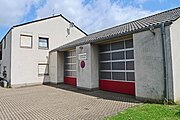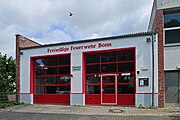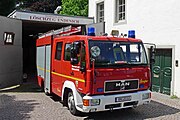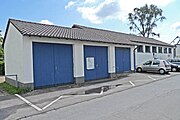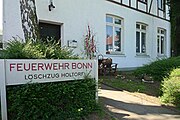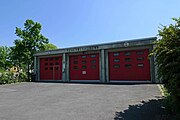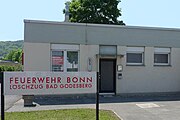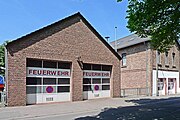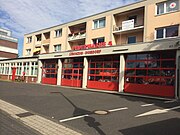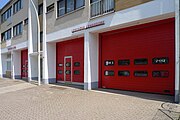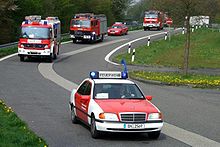Fire Brigade Bonn
| Fire Brigade Bonn | |
|---|---|
|
|
|
 Fire brigade of the Bonn fire brigade |
|
| Professional fire brigade | |
| Founding year: | 1941 |
| Locations: | 3 |
| Employee: | 370 |
| Volunteer firefighter | |
| Founding year: | 1863 |
| Departments: | 18th |
| Active members: | ~ 500 |
| Youth fire brigade | |
| Groups: | 18th |
| Members: | 320 |
| Children's fire brigade | |
| Founding year: | 2017 |
| Groups: | 1 |
| www.bonn.de/themen-enthaben/sicherheit-ordnung/feuerwehr.php | |
The Bonn fire brigade is responsible for the emergency response of the federal city of Bonn . As Office 37 it is assigned to Department I of the City of Bonn. The official name of the office is fire brigade and rescue service . Like every large German city fire brigade , it is divided into the professional fire brigade , the voluntary fire brigade and the youth fire brigade , each composed of different units with different guards.
history
Original situation
The first indications of organized fire protection in Bonn go back to 1672: The fire regulations of Elector Maximilian Heinrich von Bayern mentioned an inventory of existing fire protection equipment and saw the appointment of four fire chiefs (from the city council and representatives of the guilds) and a certain number of fire fighters in front. In addition, a fire watch occupied the tower of St. Remigius Church . However, the major fire of the electoral residence palace in 1777 clearly showed the limits of the performance possibilities.
In 1830, the Lord Mayor of Bonn, Joseph Windeck , issued new fire extinguishing regulations for the city of Bonn . The mayor or a representative appointed by him was now responsible for fire protection. A so-called deletion council was at his side as a technical advisor .
First steps along the lines of other cities
From 1853 onwards there were efforts in Bonn to follow the example of other cities and to found an organized fire brigade. Lord Mayor Leopold Kaufmann asked for help from the cities of Aachen and Cologne , which already had experience with their Pompier Corps . But it was not until 1858 that the efforts became concrete: with an appeal to the citizens of Bonn , Lord Mayor Kaufmann called for volunteers to set up an 80-man uniformed fire brigade company . The result was devastating: no volunteer volunteered. Two years later, the desired foundation gradually began to move after Mayor Kaufmann concluded an oral agreement with the gymnastics club to act as a voluntary fire and rescue corps .
The foundation
On September 20, 1862, the fire extinguishing department was transformed into a Turner fire brigade in Bonn . It consisted of 60 men in uniform and a syringe provided by the fire insurance company. On June 29, 1863 she stepped into public for the first time with an exercise on Bonn's market square.
From 1866, non-members of the gymnastics club could also join the Bonn fire brigade. In accordance with preventive fire protection , the first fire safety guards were also carried out in 1868. The construction of the Bonn hydrant network began in 1874.
Progress
When Josef Gemünd was appointed fire director in 1897, the way to extensive progress was cleared. Just one year later, the Bonn Fire Brigade District Association was founded with 25 fire brigades and around 1,000 members. At that time, numerous volunteer fire brigades were founded in the districts of Bonn and the district of Bonn.
On August 13, 1905, the Bonn fire brigade moved into its barracks in Maxstrasse in Bonn. This was inhabited by a guide and eight firefighters who could work at home and were therefore immediately available during the day in case of an emergency. At the same time, the first Bonn ambulance was put into service.
The world wars
The First World War weakened the strength of the Bonn fire brigade: 198 firefighters were drafted into the army; in the end there were 21 dead and 4 missing. Following the law on fire extinguishing in Prussia , the volunteer fire brigade was subordinated to the local police administrator on January 1, 1934. From the same day she formed the Bonn City District Fire Brigade Association . The board members were appointed by the district president. Later decrees of the interior minister regulated the management in the fight against fires and other disasters, the uniforms, the motorization and the designation. The Reich Law on Fire Extinguishing of November 23, 1938 completely eliminated the voluntary fire brigade's previous independence. It lost its legal form as an association and was transformed into a fire extinguishing police, an auxiliary police force under state supervision.
From 1945
After the end of the Second World War in 1945, the full-time fire police , which had existed since November 29, 1941, continued to operate as the Bonn professional fire brigade by order of the British military government . The remaining fire engines of the volunteer fire brigade Bonn were subordinated to her. Their total strength was initially not allowed to exceed 99 members. After the municipal reorganization in 1969, the Bonn fire department consisted of four full-time fire stations from the professional fire department and 21 fire engines from the volunteer fire department. At the beginning of the 1960s, the first youth fire departments were also founded in the volunteer fire departments. In 1982 the city administration of Bonn introduced the so-called on-call service - an alarm system with changing shifts - for the volunteer fire brigades, which became a model for many German cities.
Professional fire brigade
The professional fire brigade with its 275 officers is divided into three fire and rescue stations, each of which is manned by three guard departments in alternating shifts. The vehicle concept of the erase units of the fire brigade Bonn consists of HLF 20/16 1/1/3/ 5 , a DLK 23/12 1/1/ 2 and a TLF 20/40 1/2/ 3 total 1/3 / 6/ 10 . In addition, the transaction service comes with a MCU 1 1/1/0/ 2 disengages from the FW. 1 This results in a total thickness of 2/4/6/12 .
The city of Bonn is responsible for the rescue service. This is organized by the fire brigade, whereby the crew is partly provided by full-time workers from aid organizations or private companies according to a Europe-wide tender. The ambulance service also includes ambulance transport, which is also carried out by full-time workers from aid organizations or private companies following a Europe-wide tender on behalf of the city of Bonn. Since July 1, 2018, ambulances have also been made available at night to relieve the ambulances (RTW). If no KTW are available, ambulance can also be used for ambulance transport (and the correspondingly lower fee).
Standard extinguishing unit for fire stations 1–3
Fire station 1
Fire station 1 is located in Bonn-Tannenbusch (Lievelingsweg 112) and is also the main station. In addition to the extinguishing unit 1 (including ELW 1) and the arming unit, the control center and fire department are also housed here. 5 ambulances (RTW) and 2 emergency doctor vehicles (NEF) are also stationed on FW 1 . This is also where the control center (2 dispatchers at the desk, 2 on standby and one manned as a management assistant for the ELW in the event of an emergency), the administration, the staff rooms for disaster control, the central depot of the rescue service, the vehicle, respiratory protection, radio and hose workshop are housed . The vehicle component comprises 5 Kommandowagen , 3 Einsatzleitwagen 1 , 2 team transport vehicles , an assistance Löschgruppenfahrzeug 20/16 , a turntable ladder with basket 23-12 a pumper 20/40 , a rescue vehicle splint, a fire service crane , two swap body vehicles with different roll-off containers, a device for logistic , two telephone vehicles, 2 ambulance vehicles with one reserve vehicle each, 5 ambulances with one reserve vehicle each and an ambulance service vehicle . Three of the ambulances are manned by full-time staff from the Malteser Aid Service .
Fire station 2
Fire station 2 is located in the former independent town and current district of Beuel (Maarstrasse 8-10). The guard departments here have a staff of 24 men. In addition, the training center of the Bonn fire brigade, the administration of the volunteer fire brigade, the logistic center of the disaster control (this is not on the guard area, but in a nearby property) and some smaller workshops are housed. Fire station 2 also manned the fire-fighting boat and the multi-purpose boat of the Bonn fire brigade, which are located at the Kennedy Bridge on the Bonn side in the Rhine. The fleet includes a rescue group vehicle 20 , a turntable ladder with cage 23-12, a tank fire engine 20/40 , an animal rescue vehicle, 3 swap-loader vehicles with various roll-off containers, 2 crew transport vehicles and 3 ambulances . 2 of the ambulances are manned by full-time employees of the German Red Cross .
Fire station 3
Fire station 3 is located in the formerly independent town of Bad Godesberg (Friesdorfer Straße 160), where around 30 men are on duty per guard department. The staff is 16 people from the professional fire brigade, two paramedics from the Malteser emergency service and an emergency doctor from the Evangelical Forest Hospital around the clock. The fire station also serves as the fire station for the Bad Godesberg volunteer fire brigade (LE 31) and also houses a joinery and locksmith's shop. The fire extinguisher workshop moved to full operation on January 1, 2019 with the UKB plant fire brigade on duty. Your fleet includes assistance Löschgruppenfahrzeug 20 , a turntable ladder with basket 23-12, a pumper 20/40 , a trolley metrology , two Wechsellader vehicles with various roll-off containers, including a roll-off container for the decontamination of injured persons AB-V decontamination , for the ABC Operation and oil control, a team transport vehicle as well as 5 ambulances and an ambulance vehicle . Three ambulances are manned by full-time employees from Falck Rettungsdienst GmbH . During the day, an ambulance is parked at the Johanniter Hospital and one at Koblenzer Strasse 148.
Fire station 4 (extinguishing unit 41)
Fire station 4 is located in the Duisdorf district of the Hardtberg district (Am Burgweiher 47-49). Until 1969 it was a permanently manned fire station of the Duisdorf volunteer fire brigade in what was then the Duisdorf office . After the municipal reorganization , the fire station and vehicles, consisting of a tank fire engine 16/24 , a rescue group vehicle 20/16 , a turntable ladder with a cage 23-12 and an ambulance (forerunner of the ambulance ) were taken over and manned by the fire brigade. From 1973 fire protection was slowly returned to the hands of the Duisdorf volunteer fire brigade and, after the staff had been repeatedly reduced, only three officers from the professional fire brigade remained from 1983 for the purpose of manning an ambulance with two men and a turntable ladder with a basket with one man at the fire station. The second man for the turntable ladder with basket, as well as the staff for the other vehicles was provided by the Duisdorf volunteer fire department. In 1994, fire protection was completely transferred to the Duisdorf volunteer fire brigade and the remaining professional firefighters were withdrawn after the ambulance had previously been manned by the Johanniter Unfallhilfe and the Arbeiter-Samariter-Bund . Until June 30, 2014, three ambulances were stationed here in addition to the vehicles of the Duisdorf fire fighting unit, which were manned by the Arbeiter-Samariter-Bund.
With the commissioning of the new ambulance station 4, the ambulances were transferred to the new ambulance station. Fire station 4 is currently only the fire station of the Duisdorf fire fighting unit.
Ambulance station 4
Between 2013 and 2014, a new ambulance station was built in Lengsdorf an der Straße Auf dem Kirchbüchel in order to better comply with the rescue deadlines in guard group 4. This was officially put into operation on July 3, 2014. The ambulance station consists of a vehicle hall with 5 parking spaces, social rooms and a facility for disinfecting the ambulance service vehicle. 4 ambulances are stationed there, which are manned by the Arbeiter-Samariter-Bund . One of these ambulances is available on weekdays in the Interdisciplinary Emergency Center (INZ) of the Bonn University Hospital .
Fire department at the university clinics (FW 5)
Due to the constant growth of the Venusberg campus over the past few years and the expansion that is under construction and planned, the University Hospital has now reached a size that has made it necessary to have its own fire protection structures. A guard built by the university hospital has been in use since the end of 2018, the staff of which is provided by the professional fire brigade under a contract. An HLF 20, a DLK, a TLF and an MTF (as ELW) are currently stationed on the clinic premises. An interim guard had been set up and used in the nurses' home since 2015. The plant fire brigade has been in full operation since January 1, 2019.
training centre
The training center (ABZ) with the order number 9 is located on the premises of fire station 2 and is a training center for the entire Bonn fire service. In addition to the basic training courses for the professional fire brigade (B1 course), all training and further training courses for the volunteer fire brigade (module training for squad men, squad leaders, breathing apparatus carriers, machinists, as well as executive training) take place here. The NBC training is carried out at fire station 3, as the required vehicles are kept there. The training staff is recruited from the field of volunteer fire brigade and training, as well as from appropriately trained members of the security departments. The ABZ has two lecture halls, which are also suitable for chemistry lessons and business games, as well as corresponding practice areas for the performance of tasks. The ABZ's fleet includes an emergency fire-fighting vehicle 16 , a turntable ladder with rescue cage (e.g. reserve ladder ), a tank fire-fighting vehicle 20/40 and a hose trolley 2000 TR. These vehicles are also used during fire safety guards or major incidents by the professional and voluntary fire brigade. Also with the serial number 5, two reserve vehicles (TLF 16/25) are kept available for the volunteer fire brigade at fire station 2, which are used when the regular vehicles are in the workshop.
Operations management
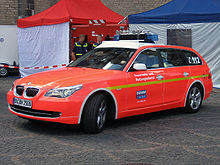

According to the current management concept, Bonn distinguishes between three command services (A, B and C service), which, depending on the situation, take over the management of operations.
- A service
Civil servant of the higher fire service from the function of the head of department or the department head or civil servant of the higher fire service from the group of subject heads as operations manager with a command vehicle , which is stationed at the fire station 1. He is used as the head of operations for larger deployments. During parallel missions he also takes on the role of the second B-Dienst. The service is perceived as a 24-hour service at fire station 1.
- B service
Official of the high-level fire service from the subject areas, who is supported by a control center dispatcher (middle level fire service) with group leader qualification ( BIII ) who also drives the command vehicle . He acts as a section leader or operations leader when the A service is not required (operations with a reinforced fire fighting unit). The B service is changed daily.
- C service
Head of the watch department of the upscale fire department A9 / A9Z / A10 or clerk of the upscale fire department (A10 / A11) as the unit leader of the respective extinguishing unit, who is also the vehicle driver of the respective HLF 20/16. He acts as a subsection leader or as an operations leader when the deployment of the B service is not required (deployment of a relay or group). C services are held at all three fire stations.
Vehicle driver of the first fire engine of the volunteer fire brigade with at least group leader qualification (FIII). If necessary, they also act as sub-section leaders or as operations leaders if the use of the professional fire brigade is not required (group operations, mostly in the outskirts).
- Ambulance service
The rescue service is led by an organizational head of the rescue service (OrgL), a senior emergency doctor (LNA) and a managerial assistant in larger emergency situations .
The OrgL has a KdoW, the collection of the LNA is arranged if necessary. Both functions are carried out in the form of on-call duty from the residential address and are alerted via digital message receivers. The OrgL is provided by full-time / voluntary employees of the aid organizations on a weekly basis.
Volunteer firefighter
The volunteer fire brigade Bonn consists of 18 departments, called extinguishing units, which are organized in four guard circles and stationed throughout the city. According to the vehicle concept, each extinguishing unit has at least one water-carrying vehicle and one crew transport vehicle. There are exceptions to this due to the special tasks of individual extinguishing units.
-
Daily alarm BBK / THW
At the beginning of 2010, a daily alarm was introduced in guard circle 4 to optimize the assistance periods. On weekdays, this consists of members of the Federal Office for Civil Protection and Disaster Relief and of the Technical Relief Organization from the joint property in Lengsdorf, who have fire service qualifications, as well as members of the Duisdorf fire fighting unit who are available during the day. A command vehicle is available for the BBK and THW employees to perform their tasks . In the event of an alarm, the vehicle is manned and fire station 4 in Duisdorf is approached directly to manning the vehicles there or to the deployment site. The daily alarm is triggered from fire level 3. The example provided, among other things, the proven project of the university fire department. Students from the Bonn-Rhein-Sieg University of Applied Sciences occupy vehicles from the Mülldorf (RSK) fire fighting train and generate daily alarm 2.
Special tasks / particularities
Water rescue

Water rescue was assigned to the fire station 2 extinguishing unit as a specialist task. One fireboat and two multi-purpose boats are manned by the watch department for operations in the allocated section of the Rhine. In addition, a water rescue equipment trolley is available, which is used for situations on inland waterways (e.g. ice rescue) throughout the city of Bonn. If divers need to be deployed, they will be requested from the Cologne fire brigade or other users ( DLRG , DRK, federal police).
The fire fighting unit is supported by members of the DLRG in Bonn as well as the volunteer fire brigade (fire fighting units Beuel and Mehlem), the latter especially in flood situations.
Animal rescue
The GW animal is stationed at fire station 2. The load includes boxes, slings and chain gloves.
Arm unit

The arming unit of the Bonn fire brigade consists of an emergency fire fighting group vehicle 20/16 , an emergency vehicle rail and a KW 25 fire brigade crane. This is supplemented by the roll-off containers "arming" and "rail" if required. The rescue vehicle rail is a 2-way vehicle. He has installed a rail set under the frame with which he can drive on the tram network. This requires authorization to drive rail vehicles in the Bonn public utility network. The load is based on the RW 3 standard applicable at the time of procurement.
The arming unit is used throughout the city for all technical assistance from alert level two (person trapped, person under tension, collapse / fall) and is supplemented by a fire protection component, consisting of vehicles from the respective fire station and units from the locally based fire fighting units of the volunteer fire brigade.
environmental Protection
The environmental unit of the fire station 3, which is composed of the fire protection component and special vehicles, belongs to environmental protection. The special vehicles include an ABC exploration vehicle and two swap-loader vehicles with various roll-off containers for ABC operations and oil control. The specialist service is supplemented by units of the volunteer fire brigade (fire fighting units Bad Godesberg and Dottendorf) each with a decontamination truck .
The environmental train is used throughout the city for dangerous goods on the road and rail or major oil damage situations and is additionally supplemented by forces from the respective local fire brigade units, since dangerous goods are very staff-intensive. The specialist service is also deployed with a measuring vehicle for gas leaks .
Telecommunication support
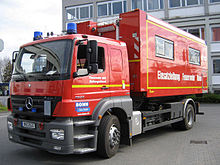
The telecommunications support specialist service is deployed to reinforce operations management in the event of major incidents or major events, both locally (reinforcement of the control center and operations command staff) and mobile (operations management on site).
It consists of members of the volunteer fire brigade (fire fighting units Bonn-Mitte, fire-fighting unit Dransdorf, fire-fighting unit Röttgen and fire-fighting unit Lannesdorf) and has the roll-off container "Operations Management" and "Meeting" (fire station 1) and two command vehicles 1 (fire fighting units Bonn-Mitte and Dransdorf) .
Local help
The supraregional help here includes the performance of tasks in the 4th readiness of the administrative district of Cologne. This task is performed by the volunteer fire brigade (extinguishing units Buschdorf, Beuel, Geislar, Bad Godesberg, Kessenich and Duisdorf).
In addition to special vehicles (turntable ladder of the Duisdorf extinguishing unit, decon vehicle of the Bad Godesberg extinguishing unit and equipment trolley logistics of the fire station 1), the respective vehicles of the extinguishing units are available as vehicles. The simple supra-local assistance within the scope of the alarm and release regulations remains unaffected.
Fire protection education

For this task, a retired ambulance was converted into an information / fire protection mobile. In addition to smoke detectors and information material, there is a wall hydrant and a gas-powered exercise object (fire extinguisher training) on the car.
Operations in highs and lows
A height rescue group is not held in Bonn. However, all employees of the professional fire brigade have been trained in the area of "fall protection" and appropriate material is available at the fire stations. If the deployment of a height rescue group is required, the height rescue group of the Cologne professional fire brigade can be used. These can also be transported by rescue helicopter.
Youth fire brigade
The youth fire brigade is the youth department of the volunteer fire brigade and is open to children and young people from the age of 10. From the age of 16, the gradual integration into the operations department takes place, which ends at the age of 18 with the takeover as a fire fighter in the operations department. In every fire brigade of the Bonn fire brigade there is a youth fire brigade of different strengths, which is led by a youth fire brigade warden. The youth fire brigades do not have their own vehicles, but use the vehicles of the emergency department. The city youth fire brigade acts as a link between the individual youth groups and the professional and voluntary fire brigade.
Web links
Coordinates: 50 ° 44 ′ 35 " N , 7 ° 4 ′ 28.7" E
Individual evidence
- ↑ a b Address by Bonn councilor Pollmann on the opening of the exhibition “50 Years of the Bonn Professional Fire Brigade” ( memento of February 22, 2013 in the Internet Archive ) on January 9, 1991.
- ^ Organization chart of the city of Bonn
- ↑ Festschrift of the Bonn-Mitte fire brigade for the 125th anniversary in 1988 ( Memento from May 18, 2010 in the Internet Archive )
- ↑ Delivery of three new TLF 20/40 from Rosenbauer
- ↑ Professional fire brigade. Retrieved June 11, 2020 .
- ↑ Flotter Flitzer for Volunteers - Article in the General-Anzeiger Bonn from September 24, 2014
- ↑ Daily alarm 2 technical college . Online at feuerwehr-sankt-augustin.org










